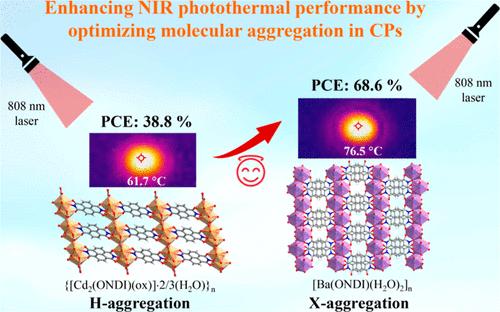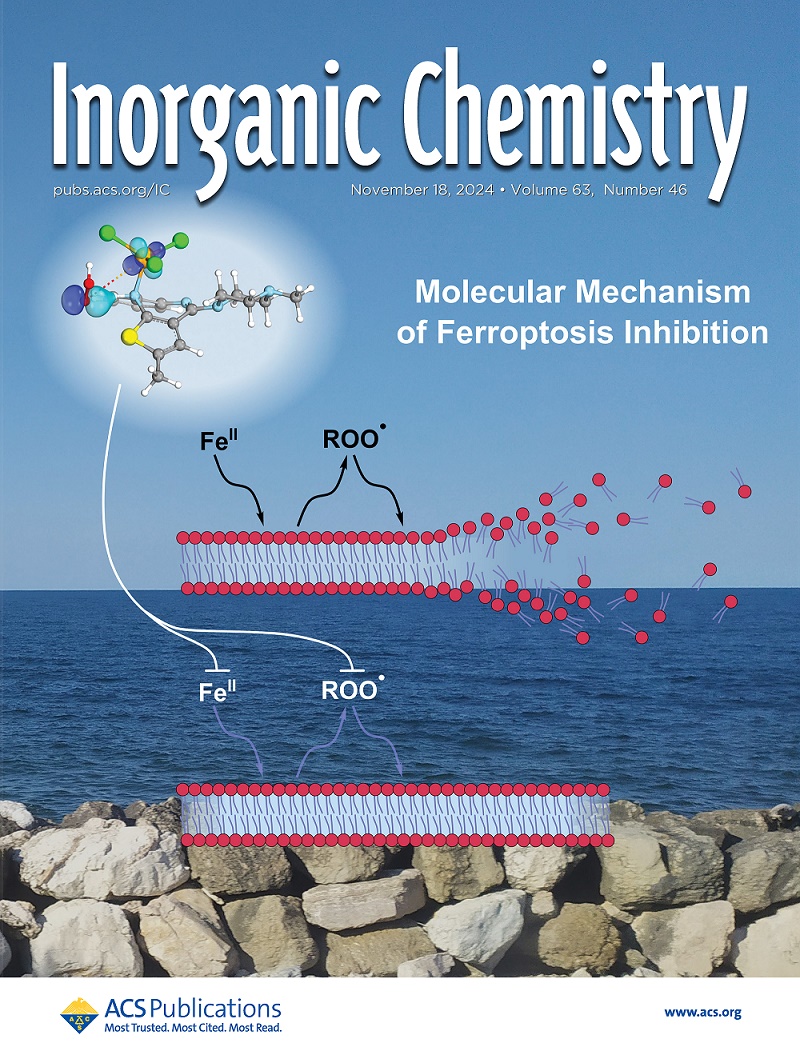Enhancing Near-Infrared Photothermal Performance by Molecular Aggregation Optimization in Semiconductive Coordination Polymers
IF 4.3
2区 化学
Q1 CHEMISTRY, INORGANIC & NUCLEAR
引用次数: 0
Abstract
Near-infrared (NIR) photothermal conversion materials have recently received widespread attention due to their potential in diverse applications. However, highly efficient organic-based NIR photothermal agents remain limited. Developing strategies to enhance the efficiency of NIR photothermal materials and elucidating the relationship between the NIR photothermal performance and molecular aggregation are highly desired. Herein, we report two coordination polymers {[Cd2(ONDI)(ox)]·2/3(H2O)}n (1) and [Ba(ONDI)(H2O)2]n (2), in which the ONDI2– ligands assemble into different π–π stacking arrangements. Compound 1 exhibits H-aggregation, while compound 2 displays X-aggregation. The X-aggregation in compound 2 extends the optical absorption into the NIR region and enhances the absorption intensity. Consequently, compound 2 demonstrates a 1.8-fold increase in NIR photothermal efficiency (68.6%) compared to compound 1 (38.8%), attributed to more effective π–π interactions in X-aggregation. In addition, both compounds show semiconductive properties, with conductivities of 2.1 × 10–7 S/cm for compound 1 and 3.0 × 10–7 S/cm for compound 2 at 30 °C in a nitrogen atmosphere. These properties arise from the synergistic effects of “band-like” charge transport within crystals and “hopping” charge transport across grain boundaries. By integration of their NIR photothermal effects and semiconductive properties, compounds 1 and 2 show interesting NIR photoelectrical responses.

通过优化半导体配位聚合物中的分子聚集提高近红外光热性能
近红外(NIR)光热转换材料因其在各种应用中的潜力而受到广泛关注。然而,高效的有机基近红外光热剂仍然有限。开发提高近红外光热材料效率的策略并阐明近红外光热性能与分子聚集之间的关系是非常必要的。在此,我们报告了两种配位聚合物{[Cd2(ONDI)(ox)]-2/3(H2O)}n(1)和[Ba(ONDI)(H2O)2]n(2),其中ONDI2-配体组装成不同的π-π堆积排列。化合物 1 显示 H-聚集,而化合物 2 显示 X-聚集。化合物 2 中的 X 聚合将光学吸收延伸到了近红外区域,并增强了吸收强度。因此,与化合物 1(38.8%)相比,化合物 2 的近红外光热效率(68.6%)提高了 1.8 倍,这归功于 X-聚集中更有效的 π-π 相互作用。此外,这两种化合物都具有半导体特性,在氮气环境中,温度为 30 °C 时,化合物 1 的导电率为 2.1 × 10-7 S/cm,化合物 2 的导电率为 3.0 × 10-7 S/cm。这些特性源于晶体内 "带状 "电荷传输和晶界间 "跳跃 "电荷传输的协同效应。通过整合近红外光热效应和半导体特性,化合物 1 和 2 显示出有趣的近红外光电响应。
本文章由计算机程序翻译,如有差异,请以英文原文为准。
求助全文
约1分钟内获得全文
求助全文
来源期刊

Inorganic Chemistry
化学-无机化学与核化学
CiteScore
7.60
自引率
13.00%
发文量
1960
审稿时长
1.9 months
期刊介绍:
Inorganic Chemistry publishes fundamental studies in all phases of inorganic chemistry. Coverage includes experimental and theoretical reports on quantitative studies of structure and thermodynamics, kinetics, mechanisms of inorganic reactions, bioinorganic chemistry, and relevant aspects of organometallic chemistry, solid-state phenomena, and chemical bonding theory. Emphasis is placed on the synthesis, structure, thermodynamics, reactivity, spectroscopy, and bonding properties of significant new and known compounds.
 求助内容:
求助内容: 应助结果提醒方式:
应助结果提醒方式:


